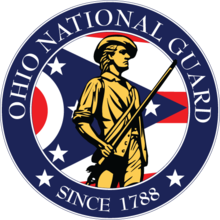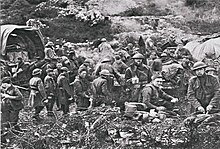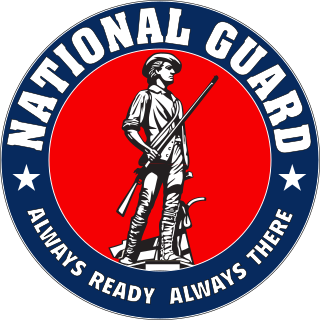
The National Guard is a state-based military force that becomes part of the reserve components of the United States Army and the United States Air Force when activated for federal missions. It is a military reserve force composed of National Guard military members or units of each state and the territories of Guam, the Virgin Islands, Puerto Rico, and the District of Columbia, for a total of 54 separate organizations. It is officially created under Congress's Article 1 Section 8 ability to "raise and support armies". All members of the National Guard are also members of the organized militia of the United States as defined by 10 U.S.C. § 246. National Guard units are under the dual control of state governments and the federal government.

The 37th Infantry Division was a unit of the United States Army in World War I and World War II. It was a National Guard division from Ohio, nicknamed the "Buckeye Division". Today, its lineage is continued through the 37th Infantry Brigade Combat Team, with battalions from Ohio, Michigan, and South Carolina.
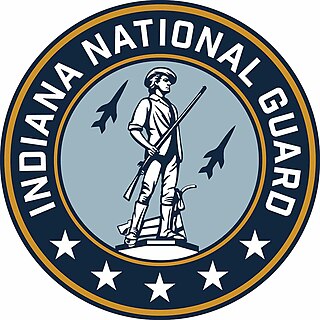
The Indiana National Guard (INNG) is a component of the United States Armed Forces, the United States National Guard and the Military Department of Indiana (MDI). It consists of the Indiana Army National Guard, the Indiana Air National Guard, and the Adjutant General's Office.

The Kansas National Guard, is the component of the United States National Guard in the U.S. state of Kansas. It comprises both the Kansas Army National Guard and the Kansas Air National Guard. The Governor of Kansas is Commander-in-Chief of the Kansas National Guard when in state use. The State's highest-ranking military commander, the Adjutant General of Kansas, serves as the military head of the Guard and is second only to the Governor.

The Minnesota National Guard is a state-based military force of more than 13,000 soldiers and airmen, serving in 61 communities across the state. Operated in the U.S. state of Minnesota, it is reserve component of the National Guard.

The Nevada National Guard is the component of the United States National Guard in Nevada. The governor of Nevada may call individuals or units of the Nevada National Guard into state service. The Constitution of the United States charges the National Guard of each state to support its dual federal and state missions.

The New Mexico National Guard is the militia of the U.S. state of New Mexico. Comprising the New Mexico Army National Guard and the New Mexico Air National Guard, it is part of the National Guard of the United States, a reserve force under both state and federal jurisdiction.

The Oklahoma National Guard, a division of the Oklahoma Military Department, is the component of the United States National Guard in the U.S. state of Oklahoma. It comprises both Army (OKARNG) and Air (OKANG) National Guard components. The Governor of Oklahoma is Commander-in-Chief of the Oklahoma National Guard when not on federal active duty. The state's highest-ranking military commander, the Adjutant General of Oklahoma (TAG), serves as the military head of the Guard and is second only to the Governor. The TAG is served by Assistant Adjutants General, all brigadier generals, from the OKARNG and OKANG. The two components each have a senior noncommissioned officer, State Command Sergeant Major for Army and State Command Chief Master Sergeant for Air. The TAG is also served by his Director of the Joint Staff or Chief of Staff, who has direct oversight of the state's full-time National Guard military personnel and civilian employees.

The Pennsylvania National Guard is one of the oldest and largest National Guards in the United States Department of Defense. It traces its roots to 1747 when Benjamin Franklin established the Associators in Philadelphia.
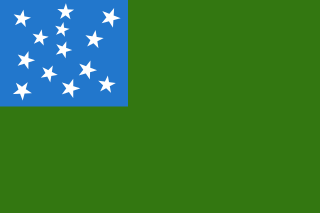
The Vermont National Guard is composed of the Vermont Army National Guard and the Vermont Air National Guard. Together, they are collectively known as the Green Mountain Boys. Both units use the original Revolutionary War-era Flag of the Green Mountain Boys as their banner. In 2009, they had 2,600 members.
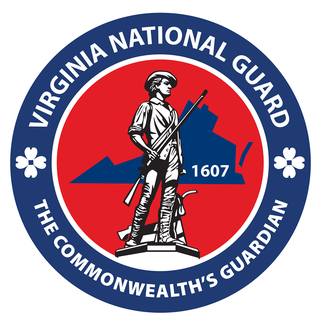
The Virginia National Guard consists of the Virginia Army National Guard and the Virginia Air National Guard. It is part of the Government of Virginia though the National Guard across the United States is mostly funded by the federal government. The National Guard is the only United States military force empowered to function in a state status. Those functions range from limited actions during non-emergency situations to full scale law enforcement of martial law when local law enforcement officials can no longer maintain civil control. The National Guard may be called into federal service in response to a call by the President or Congress, in accordance with Title 10 of the United States Code.
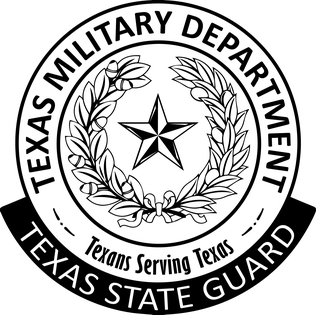
The Texas State Guard (TXSG) is part of the state military force of Texas, and one of three branches of the Texas Military Forces. Along with the other two branches, the TXSG falls under the command of the Governor of Texas and is administered by the Adjutant General of Texas, an appointee of the Governor. The other two branches of the Texas Military Forces are the Texas Army National Guard and the Texas Air National Guard.

The Ohio Army National Guard is a part of the Ohio National Guard and the Army National Guard of the United States Army. It is also a component of the organized militia of the state of Ohio, which also includes the Ohio Naval Militia, the Ohio Military Reserve and the Ohio Air National Guard. The Ohio Army National Guard consists of a variety of combat, combat support, and combat service support units. As of September 2010, its end strength exceeded 11,400 soldiers. Its headquarters is the Beightler Armory in Columbus, Ohio. Many units conduct Annual Training at Camp Grayling, Michigan.

The 37th Infantry Brigade Combat Team (Buckeye) is an infantry brigade combat team of the United States Army National Guard with the brigade headquarters, cavalry squadron, infantry battalion, field artillery battalion, engineer battalion, and support battalion stationed in Ohio, infantry battalion and military intelligence company stationed in Michigan, and a third infantry battalion stationed in South Carolina. The 37th IBCT traces its lineage and honors back to the 37th Infantry Division.

The Militia Act of 1903, also known as the Efficiency in Militia Act of 1903 or the Dick Act, was legislation enacted by the United States Congress to create what would become the modern National Guard from a subset of the militia, and codify the circumstances under which the Guard could be federalized. It also provided federal funds to pay for equipment and training, including annual summer encampments. The new National Guard was to organize units of similar form and quality to those of the regular Army, and intended to achieve the same training, education, and readiness requirements as active duty units.

The Rhode Island Army National Guard (RIARNG) is the land force militia for the U.S. state of Rhode Island. It operates under Title 10 and Title 32 of the United States Code and operates under the command of the state governor while not in federal service. National Guard units may function under arms in a state status, therefore they may be called up for active duty by the governor to help respond to domestic emergencies and disasters, such as those caused by hurricanes, floods, or civil unrest.
The 148th Infantry Regiment is an Ohio Army National Guard parent regiment under the U.S. Army Regimental System, with headquarters at Walbridge, Ohio. It currently consists of the 1st Battalion, 148th Infantry Regiment, an infantry battalion of the 37th Infantry Brigade Combat Team located throughout northwest Ohio.

The history of the Arkansas National Guard and World War I begins with the reorganization of the Arkansas State Guard following the Spanish–American War. As a result of difficulties encountered during the mobilization of state militia forces, the United States Congress passed new legislation which resulted in the renaming of the Arkansas State Guard as the Arkansas National Guard. The new federal legislation resulted in increased funding and training for the guard. The newly reorganized Arkansas National Guard was call upon by the President to help defend the border with Mexico in 1916 in response to cross border raids during the Mexican Revolution. The Arkansas National Guard had just returned from the Mexican Expedition in 1917 when it was activated for World War I. As a part of their incorporation in the United States Army, all National Guard units were renumbered in accordance with a federal system. The Arkansas National Guard units were incorporated into the 39th Infantry Division and after training at Camp Beauregard, were shipped to France in August and September 1918. The 39th Division was broken up, with some units being used as replacements for other divisions. Most former Arkansas National Guardsmen returned to the United States in February through June 1919 and were demobilized.

The 145th Armored Regiment, Ohio Army National Guard, is a parent regiment under the U.S. Army Regimental System, with headquarters at Stow, Ohio. It currently consists of the 1st Battalion, 145th Armored Regiment, a 600-soldier combined arms battalion of the Ohio Army National Guard located throughout northeast Ohio.
The history of the Army National Guard in the United States dates from 1636, when the Massachusetts Bay Colony's government organized existing militia companies into three regiments. The National Guard's history continued through the colonial era, including the French and Indian War, and extends into the modern era, including participation in the War on Terror.
